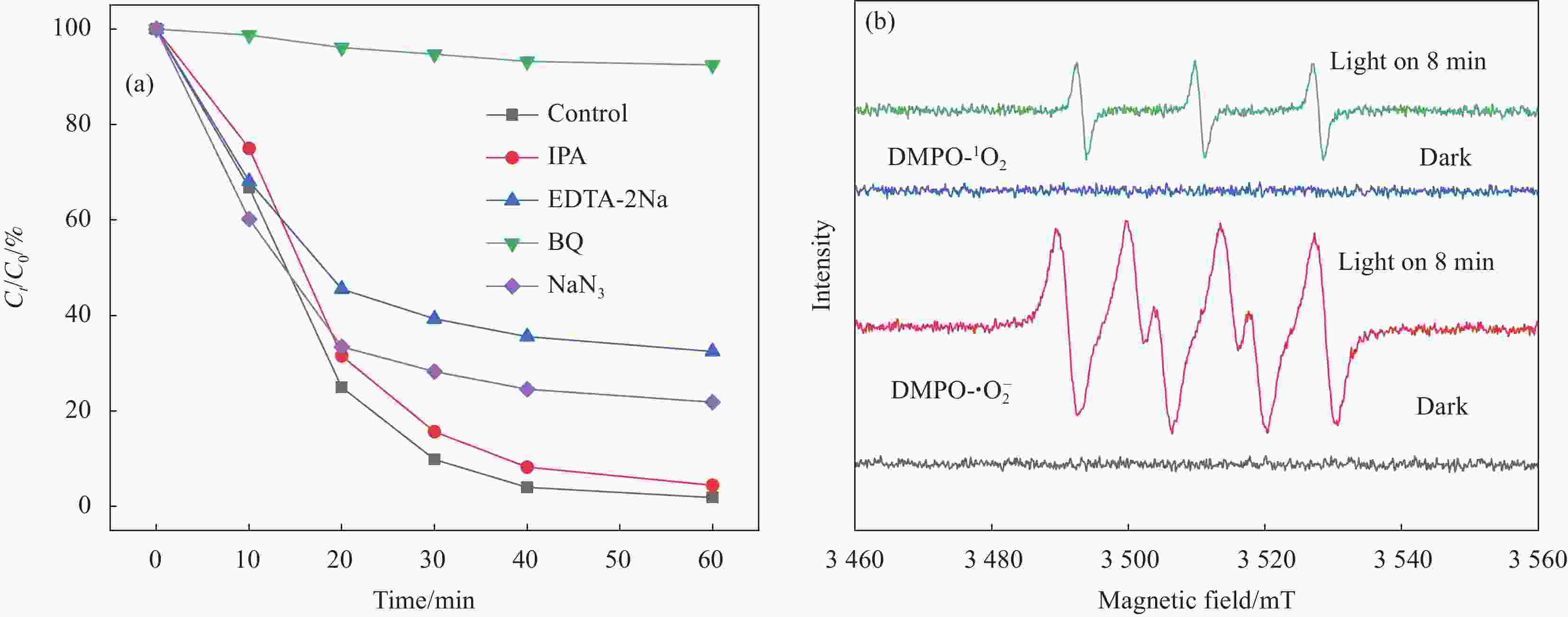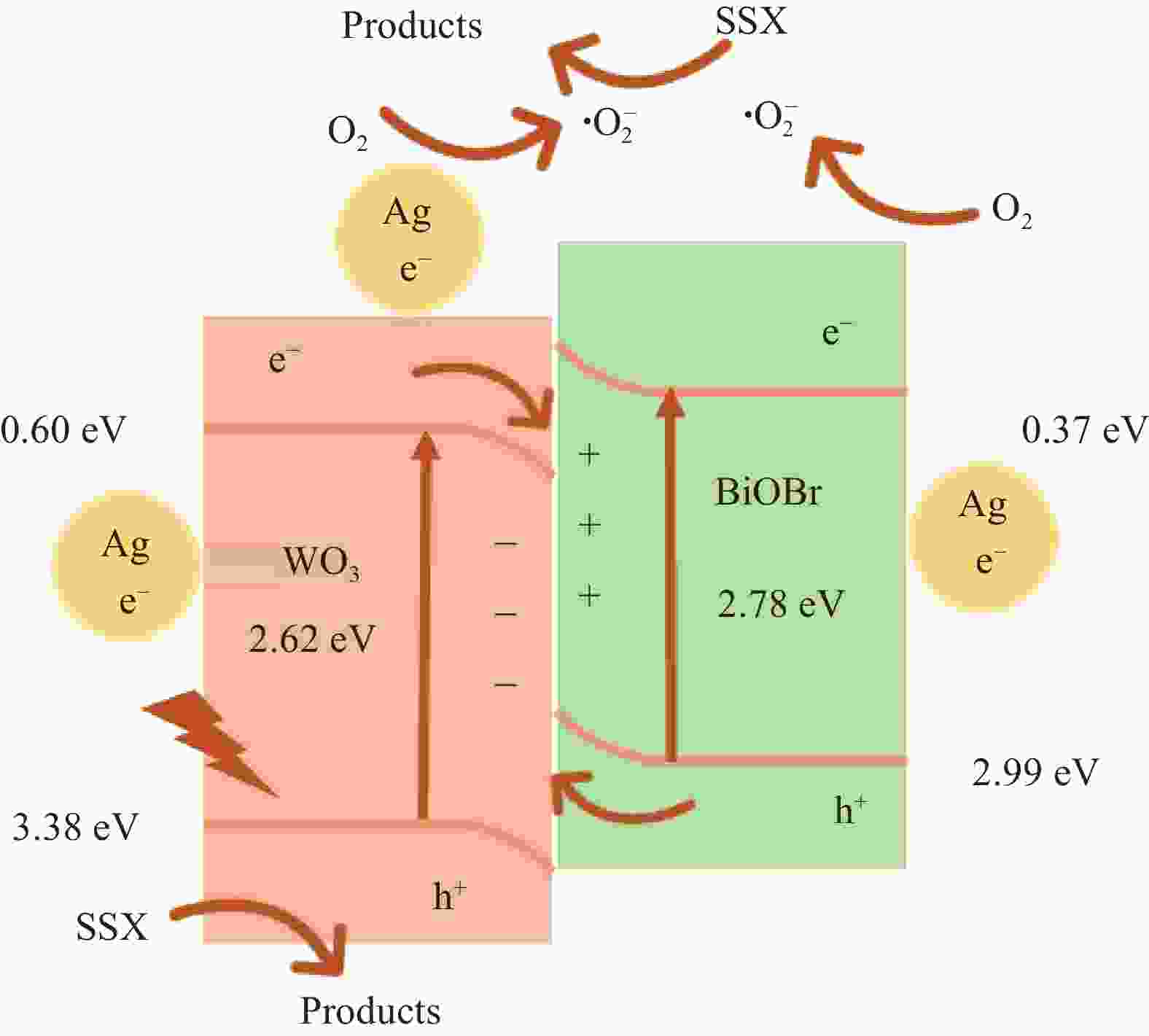Preparation of Ag-BiOBr/WO3 composites and enhanced sulfisoxazole removal performance
-
摘要: 抗生素类药物因其抗菌效果好在人畜医疗等领域得到广泛应用,但其在环境中难以自然分解,光催化氧化技术在降解持久型有机物方面有着光明的应用前景。然而,常规的光催化材料光谱吸收范围不够宽、光生载流子复合率过高,严重制约了催化材料的应用推广。因此,亟待研发更有效安全的去除技术。本文利用光沉积法将Ag单质负载于BiOBr/WO3 p-n型异质结材料表面,构建出新型Ag-BiOBr/WO3材料,并将其用于光催化降解磺胺异噁唑。采用XRD、TEM、XPS、UV-vis DRS等技术对其进行表征表明,Ag的沉积拓展了材料的光响应范围,显著加快光生载流子的分离速度,从而提高了光催化性能。单质Ag含量为15wt%的材料为降解磺胺异噁唑效率最高的复合材料。当溶液中催化剂浓度为0.3 g/L,磺胺异噁唑浓度为5 mg/L,pH为7时,在60 min时光催化降解磺胺异噁唑的效率最高,可达98.1%,降解速率常数分别为BiOBr、WO3和BiOBr/WO3的28.79倍、36.37倍和7.59倍。经过5次循环实验后,15wt%Ag-BiOBr/WO3复合材料仍具备较高的光催化活性,表明材料可循环回收利用,具备良好的稳定性。淬灭实验和电子自旋共振(ESR)结果表明,•O2–为15wt%Ag-BiOBr/WO3体系中最活跃的自由基团,而1O2和h+发挥了次要作用。这为催化材料的制备和抗生素降解提供了理论基础。Abstract: Antibiotics have been widely used to treat human and animal diseases with good antibacterial effect. However, antibiotics are difficult to be degraded naturally in natural environment. The photocatalytic oxidation technology has bright application prospects in the degradation of persistent organic compounds. However, the spectral absorption range of conventional photocatalytic materials is not wide enough, and the recombination rate of photogenerated carriers is too high, which seriously restricts the application and promotion of catalytic materials. So, it is urgent to develop more effective and safe removal technologies. The photodeposition method was used to load Ag element on the surface of BiOBr/WO3 p-n type heterojunction material to construct a new type of Ag-BiOBr/WO3 material and apply to the photocatalytic degradation of sulfisoxazole. The samples were characterized by various techniques, such as XRD, TEM, XPS, UV-vis DRS et al. The result show that the deposition of Ag expands the photo-response range of the material, significantly accelerates the separation speed of photogenerated carriers, and thus improves the photocatalytic performance. The 15wt%Ag-BiOBr/WO3 with an Ag content of 15wt% is considered to be the most efficient composite material for the removal of sulfisoxazole. When the catalyst concentration is 0.3 g/L, the sulfisoxazole concentration is 5 mg/L, and the pH is 7, 15wt%Ag-BiOBr/WO3 demonstrates the highest photocatalytic degradation efficiency of sulfisoxazole in 60 min, which reaches up to 98.1%. The degradation rate is 28.79, 36.37 and 7.59 times higher than those of BiOBr, WO3 and BiOBr/WO3, respectively. After 5 cycles of experiments, the 15wt%Ag-BiOBr/WO3 composite material still maintains high photocatalytic activity, indicating that the material can be recycled and reuses with good stability. The quenching experiments and electron spin resonance (ESR) shows that •O2– is the most active radical group in the BiOBr/WO3 system, while 1O2 and h+ played relatively minor roles. This provides a theoretical basis for the preparation of catalytic materials and the degradation of antibiotics.
-
Key words:
- sulfisoxazole /
- photocatalytic technology /
- bismuth bromide oxide /
- tungsten trioxide /
- silver
-
图 10 (a) 15wt%Ag-BiOBr/WO3降解磺胺异噁唑(SSX)过程中的自由基捕获实验(浓度[SSX]=5 mg/L、[15wt%Ag-BiOBr/WO3]=0.3 g/L); (b) 1O2和•O2–的电子顺磁共振检测
Figure 10. (a) Free radical capture experiment in the process of 15wt%Ag-BiOBr/WO3 degradation of sulfisoxazole (SSX) (Concentration [SSX]=5 mg/L, [15wt%Ag-BiOBr/WO3]=0.3 g/L); (b) Electron paramagnetic resonance detection of 1O2 and •O2–
IPA—Isopropanol; EDTA-2Na—Disodium ethylene diamine tetraacetic acid; BQ—Benzoquinone
表 1 Ag-BiOBr/WO3复合材料比例
Table 1. Proportion of Ag-BiOBr/WO3 composites
Specimen Mass fraction of Ag/wt% BiOBr/WO3 0 1wt%Ag-BiOBr/WO3 1 5wt%Ag-BiOBr/WO3 5 10wt%Ag-BiOBr/WO3 10 15wt%Ag-BiOBr/WO3 15 20wt%Ag-BiOBr/WO3 20 表 2 氮气吸附-脱附法测定复合材料比表面积
Table 2. Nitrogen adsorption-desorption method to determine the specific surface area of composite materials
Sample Specific surface
area/(m2·g–1)Pore volume/
(cm3·g–1)Average pore
size/nmWO3 6.5917 0.0088 5.3087 BiOBr 12.4277 0.0158 5.0858 BiOBr/WO3 13.6590 0.0685 20.5770 15wt%Ag-BiOBr/WO3 9.0180 0.0431 19.1025 -
[1] 唐才明, 黄秋鑫, 余以义, 等. 高效液相色谱-串联质谱法对水环境中微量磺胺、大环内酯类抗生素、甲氧毕胺嘧啶与氯霉素的检测[J]. 分析测试学报, 2009, 28(8):909-913. doi: 10.3969/j.issn.1004-4957.2009.08.007TANG Caiming, HUANG Qiuxin, YU Yiyi, et al. Simultaneous determination of trace sulfonamides, macrolides, trimethoprim and chloramphenicol in aquatic environment using liquid chromatography tandem mass spectrometry[J]. Journal of Instrumental Analysis,2009,28(8):909-913(in Chinese). doi: 10.3969/j.issn.1004-4957.2009.08.007 [2] LUO Y, XU L, RYSZ M, et al. Occurrence and transport of tetracycline, sulfonamide, quinolone, and macrolide antibiotics in the Haihe river basin, China[J]. Environmental Science & Technology,2011,45(5):1827-1833. [3] LIGUORO M, RIGA A, FARISELLI P. Synergistic toxicity of some sulfonamide mixtures on daphnia magna[J]. Ecotoxicology and Environmental Safety,2018,164:84-91. doi: 10.1016/j.ecoenv.2018.08.011 [4] SCHMITT H, STOOB K, HAMSCHER G, et al. Tetracyclines and tetracycline resistance in agricultural soils: Microcosm and field studies[J]. Microbial Ecology,2006,51(3):267-276. doi: 10.1007/s00248-006-9035-y [5] RODRIGUEZ-MOZAZ S, CHAMORRO S, MARTI E, et al. Occurrence of antibiotics and antibiotic resistance genes in hospital and urban wastewaters and their impact on the receiving river[J]. Water Research,2015,69:234-242. doi: 10.1016/j.watres.2014.11.021 [6] LI B, YANG Y, MA L, et al. Metagenomic and network analysis reveal wide distribution and co-occurrence of environmental antibiotic resistance genes[J]. The ISME Journal,2015,9(11):2490-2502. doi: 10.1038/ismej.2015.59 [7] 常亮亮, 于艳, 曹宝月, 等. 可循环利用BiOBr/石墨烯水凝胶复合材料的制备及其对丁基钠黄药的降解性能[J]. 复合材料学报, 2021, 38(3):832-842.CHANG Liangliang, YU Yan, CAO Baoyue, et al. Preparation of recyclable BiOBr/graphene hydrogel composite and its photodegradation of sodium butyl xanthate[J]. Acta Materiae Compositae Sinica,2021,38(3):832-842(in Chinese). [8] WESTERHOFF P, YOON Y, SNYDER S, et al. Fate of endocrine-disruptor, pharmaceutical, and personal care product chemicals during simulated drinking water treatment processes[J]. Environmental Science& Technology,2005,39(17):6649-6663. [9] CHEN H, GAO B, LI H. Removal of sulfamethoxazole and ciprofloxacin from aqueous solutions by graphene oxide[J]. Journal of Hazardous Materials,2015,282:201-207. [10] CHEN L, TANG J, SONG L, et al. Heterogeneous photocatalysis for selective oxidation of alcohols and hydrocarbons[J]. Applied Catalysis B: Environmental,2019,242:379-388. doi: 10.1016/j.apcatb.2018.10.025 [11] SMAZNA D, SHREE S, POLONSKYI O, et al. Mutual interplay of ZnO micro- and nanowires and methylene blue during cyclic photocatalysis process[J]. Journal of Environmental Chemical Engineering,2019,7(2):103016. doi: 10.1016/j.jece.2019.103016 [12] SONG Y, TIAN J, GAO S, et al. Photodegradation of sulfonamides by g-C3N4 under visible light irradiation: Effectiveness, mechanism and pathways[J]. Applied Catalysis B: Environmental,2017,210:88-96. doi: 10.1016/j.apcatb.2017.03.059 [13] YANG H, LI G, AN T, et al. Photocatalytic degradation kinetics and mechanism of environmental pharmaceuticals in aqueous suspension of TiO2: A case of sulfa drugs[J]. Catalysis Today,2010,153(3-4):200-207. doi: 10.1016/j.cattod.2010.02.068 [14] ZHAO C, LI W, LIANG Y, et al. Synthesis of BiOBr/carbon quantum dots microspheres with enhanced photoactivity and photostability under visible light irradiation[J]. Applied Catalysis A: General,2016,527:127-136. doi: 10.1016/j.apcata.2016.09.005 [15] HUO Y, ZHANG J, MIAO M, et al. Solvothermal synthesis of flower-like BiOBr microspheres with highly visible-light photocatalytic performances[J]. Applied Catalysis B: Environmental,2012,111-112:334-341. doi: 10.1016/j.apcatb.2011.10.016 [16] 李婷婷. 含铋氧化物复合光催化材料的制备及其光催化降解有机污染物[D]. 长沙: 湖南大学, 2015.LI Tingting. Bimuth-containing oxide composite photocatalytic materials: preparation and their application of organic pollutants degradation[D]. Changsha: Hunan University, 2015(in Chinese). [17] ZHANG T, CHANG F, QI Y, et al. A facile one-pot and alkali-free synthetic procedure for binary SnO2/g-C3N4 compo-sites with enhanced photocatalytic behavior[J]. Materials Science in Semiconductor Processing,2020,115:105-112. [18] GAO S, GUO C, LV J, et al. A novel 3D hollow magnetic Fe3O4/BiOI heterojunction with enhanced photocatalytic performance for bisphenol A degradation[J]. Chemical Engineering Journal,2017,307:1055-1065. doi: 10.1016/j.cej.2016.09.032 [19] LIU Y, ZHANG H, KE J, et al. 0D (MoS2)/2D (g-C3N4) heterojunctions in Z-scheme for enhanced photocatalytic and electrochemical hydrogen evolution[J]. Applied Catalysis B: Environmental,2018,228:64-74. doi: 10.1016/j.apcatb.2018.01.067 [20] 黄有鹏, 吴福礼, 李兵, 等. WO3/g-C3N4复合光催化剂制备及其可见光催化性能[J]. 复合材料学报, 2021, 38(12):4265-4272.HUANG Youpeng, WU Fuli, LI Bing, et al. Preparation and visible light catalytic performance of WO3/g-C3N4 compo-site photocatalyst[J]. Acta Materiae Compositae Sinica,2021,38(12):4265-4272(in Chinese). [21] LEILA D, NEMAT T. One-step synthesis of BiOBr/WO3. 0.33 H2O composite for highly efficient visible-light-driven photocatalyst[J]. Solid State Sciences,2019,98:106021. doi: 10.1016/j.solidstatesciences.2019.106021 [22] GUO C, HE Y, DU P, et al. Novel magnetically recoverable BiOBr/iron oxides heterojunction with enhanced visible light-driven photocatalytic activity[J]. Applied Surface Science,2014,320:383-390. doi: 10.1016/j.apsusc.2014.09.111 [23] DUO F F, WANG Y W, MAO X M, et al. Double Br sources fabrication and photocatalytic property of p-n junction BiOBr/ZnO composites for phenol removal[J]. Crystal Research and Technology,2014,49(9):721-730. doi: 10.1002/crat.201400076 [24] WANG J, ZHANG G K, LI J, et al. Novel three-dimensional flowerlike BiOBr/Bi2SiO5 p-n heterostructured nanocomposite for degradation of tetracycline: Enhanced visible light photocatalytic activity and mechanism[J]. ACS Sustainable Chemistry & Engineering,2018,6(11):14221-14229. [25] WU X B, ZHOU H L, GU S N, et al. In situ preparation of novel heterojunction BiOBr/BiVO4 photocatalysts with enhanced visible light photocatalytic activity[J]. RSC Advances,2015,5(112):92769-92777. doi: 10.1039/C5RA17552F [26] LIU H J, DU C W, LI M, et al. One-pot hydrothermal synthesis of SnO2/BiOBr heterojunction photocatalysts for the efficient degradation of organic pollutants under visible light[J]. ACS Applied Materials & Interfaces,2018,10(34):28686-28694. [27] 肖维, 张柯杰, 傅炀杰, 等. Bi/WO3复合光催化材料的制备及其抗菌性能[J]. 复合材料学报, 2021, 38(12):4198-4204.XIAO Wei, ZHANG Kejie, FU Yangjie, et al. Preparation of Bi/WO3 composite photocatalytic materials with antibacterial properties[J]. Acta Materiae Compositae Sinica,2021,38(12):4198-4204(in Chinese). [28] LIU H, SU Y, CHEN Z, et al. Novel 3D flowerlike Au/BiOBr0.2I0.8 composites with highly enhanced visible-light photocatalytic performances[J]. Separation & Purification Technology, 2014, 133: 343-350. [29] GUO W, QIN Q, GENG L, et al. Morphology-controlled preparation and plasmon-enhanced photocatalytic activity of Pt–BiOBr heterostructures[J]. Journal of Hazardous Materials, 2016, 308: 374-385. [30] MENG X, LI Z, CHEN J, et al. Enhanced visible light-induced photocatalytic activity of surface-modified BiOBr with Pd nanoparticles[J]. Applied Surface Science, 2018, 433: 76-87. [31] YU C, FAN C, MENG X, et al. A novel Ag/BiOBr nanoplate catalyst with high photocatalytic activity in the decomposition of dyes[J]. Reaction Kinetics, Mechanisms and Catalysis,2011,103(1):141-151. doi: 10.1007/s11144-011-0291-6 [32] REGMI C, DHAKAL D, KIM T H, et al. Fabrication of Ag-decorated BiOBr-mBiVO4 dual heterojunction composite with enhanced visible light photocatalytic performance for degradation of malachite green[J]. Nanotechnology,2018,29(15):154001. doi: 10.1088/1361-6528/aaac60 [33] WEN P H, WANG C C, LAN Y Z, et al. In situ synthesis of crystalline Ag-WO3 nanosheets with enhanced solar photo-electrochemical performance for splitting water[J]. CrystEngComm,2020,22(1):105-112. doi: 10.1039/C9CE01392J [34] KHAMPUANBUT A, SANTALELAT S, PANKIEW A, et al. Visible-light-driven WO3/BiOBr heterojunction photocatalysts for oxidative coupling of amines to imines: Energy band alignment and mechanistic insight[J]. Journal of Colloid and Interface Science,2019,560:213-224. [35] CHEN M, GUO C, HOU S, et al. In-situ fabrication of Ag/Pg-C3N4 composites with enhanced photocatalytic activity for sulfamethoxazole degradation[J]. Journal of Hazardous Materials,2019,366:219-228. doi: 10.1016/j.jhazmat.2018.11.104 [36] 卞俊杰, 王万圆, 满恒孝, 等. BiOX(Cl, Br, I)/Bi2WO6异质结型复合光催化剂用于高浓度氮氧化物的脱除[J]. 化工进展, 2021, 40(11):6094-6101.BIAN Junjie, WANG Wanyuan, MAN Hengxiao, et al. BiOX(Cl, Br, I)/Bi2WO6 heterojunction composites as photocatalysts for high concentration NO removal[J]. Chemical Industry and Engineering Progress,2021,40(11):6094-6101(in Chinese). [37] LING Y, DAI Y. Direct Z-scheme hierarchical WO3/BiOBr with enhanced photocatalytic degradation performance under visible light[J]. Applied Surface Science,2020,509:145201. doi: 10.1016/j.apsusc.2019.145201 [38] 梁兰兰. 铋系半导体光催化剂的制备及其对水中痕量药物卡马西平的降解特性研究[D]. 西安: 长安大学, 2019.LIANG Lanlan. Synthesis of bismuth-based photocatalysts and their photocatalytic degradation of trace pharmaceutical carbamazepine in aquatic solution[D]. Xi'an: Chang'an University, 2019(in Chinese). [39] VAIANO V, MATARANGOLO M, MURCIA J, et al. Enhanced photocatalytic removal of phenol from aqueous solutions using ZnO modified with Ag[J]. Applied Catalysis B: Environmental,2018,225:197-206. doi: 10.1016/j.apcatb.2017.11.075 [40] ZHANG S, WANG D. Preparation of novel BiOBr/CeO2 heterostructured photocatalysts and their enhanced photocatalytic activity[J]. RSC Advances,2015,5(113):93032-93040. doi: 10.1039/C5RA13581H [41] HU T, YANG Y, DAI K, et al. A novel Z-scheme Bi2MoO6/BiOBr photocatalyst for enhanced photocatalytic activity under visible light irradiation[J]. Applied Surface Science,2018,456:473-481. doi: 10.1016/j.apsusc.2018.06.186 [42] OU M, WAN S, ZHONG Q, et al. Hierarchical Z-scheme photocatalyst of g-C3N4@Ag/BiVO4 (040) with enhanced visible-light-induced photocatalytic oxidation performance[J]. Applied Catalysis B: Environmental,2018,221:97-107. doi: 10.1016/j.apcatb.2017.09.005 [43] AMORNRAT K, SARUNYA S, APIRAK P, et al. Visible-light-driven WO3/BiOBr heterojunction photocatalysts for oxidative coupling of amines to imines: Energy band alignment and mechanistic insight[J]. Journal of Colloid and Interface Science,2020,560:213-224. doi: 10.1016/j.jcis.2019.10.057 [44] 仇宏暄, 余义昌, 黎城君, 等. SiO2/BiOBr光催化材料制备及其对含油废水的处理[J]. 化工进展, 2019, 38(9):4085-4094.QIU Hongxuan, YU Yichang, LI Chengjun, et al. Preparation of SiO2/BiOBr photocatalytic materials and treatment ofoily wastewater[J]. Chemical Industry and Engineering Progress,2019,38(9):4085-4094(in Chinese). [45] SHARMA V K, MISHRA S K, NESNAS N. Oxidation of sulfonamide antimicrobials by ferrate (VI)[FeVIO42-][J]. Environmental Science & Technology,2006,40(23):7222-7227. [46] BOREEN A L, ARNOLD W A, MCNEILL K. Triplet-sensitized photodegradation of sulfa drugs containing six-membered heterocyclic groups: Identification of an SO2 extrusion photoproduct[J]. Environmental Science & Technology,2005,39(10):3630-3638. [47] SHI W, YAN Y, YAN X. Microwave-assisted synthesis of nano-scale BiVO4 photocatalysts and their excellent visible-light-driven photocatalytic activity for the degradation of ciprofloxacin[J]. Chemical Engineering Journal,2013,215:740-746. [48] DI J, XIA J, GE Y, et al. Facile fabrication and enhanced visible light photocatalytic activity of few-layer MoS2 coupled BiOBr microspheres[J]. Dalton transactions,2014,43(41):15429-15438. doi: 10.1039/C4DT01652A [49] WANG Y, JUNG D. Synthesis of novel BiOCl/LiBiO3 p-n heterojunction photocatalysts and their enhanced photocatalytic performance[J]. Solid State Sciences, 2019, 91: 42-48. [50] ZHANG J, ZHANG L, SHEN X, et al. Synthesis of BiOBr/WO3 p-n heterojunctions with enhanced visible light photocatalytic activity[J]. CrystEngComm,2016,18:3856-3865. doi: 10.1039/C6CE00824K [51] WAGEH S, AL-GHAMDI A A, JAFER R, et al. A new heterojunction in photocatalysis: S-scheme heterojunction[J]. Chinese Journal of Catalysis,2021,42(5):667-669. doi: 10.1016/S1872-2067(20)63705-6 [52] ZHANG L, ZHANG J, YU H, et al. Emerging S-scheme photocatalyst[J]. Advanced Materials, 2022, 34 (11): e2107668. [53] JIN Z, LI Y, MA Q. CoAl LDH@Ni-MOF-74 S-scheme heterojunction for efficient hydrogen evolution[J]. Transactions of Tianjin University,2021,27:127-138. doi: 10.1007/s12209-020-00269-1 [54] GUO C, GAO S, LV J, et al. Assessing the photocatalytic transformation of norfloxacin by BiOBr/iron oxides hybrid photocatalyst: Kinetics, intermediates, and influencing factors[J]. Applied Catalysis B: Environmental,2017,205:68-77. doi: 10.1016/j.apcatb.2016.12.032 -






 下载:
下载:














